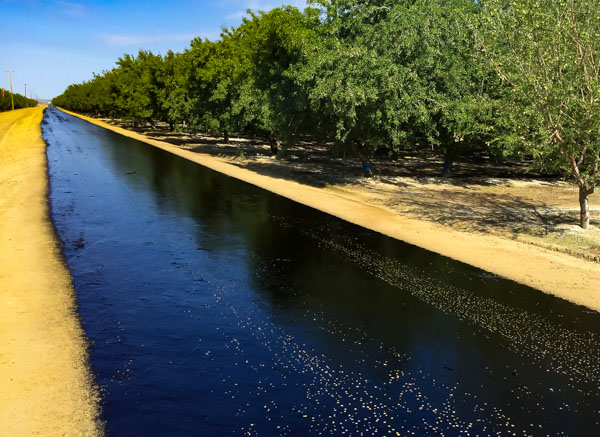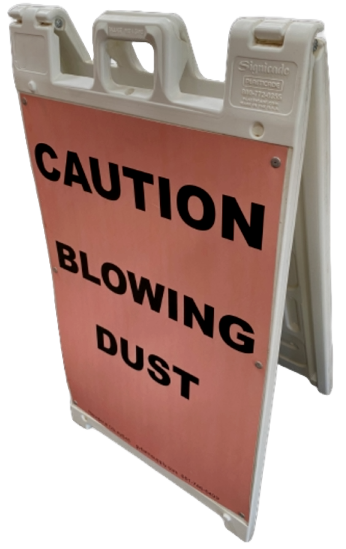Almond harvesting is an important process that requires careful planning and execution. However, it can also generate a lot of dust that affects the environment, workers, and surrounding community. Dust can reduce air quality, reduce visibility, and cause health problems for people and animals. Therefore, it is important for almond growers to adopt farming practices which will reduce dust during almond harvest.
In this blog post, I will share some tips and best practices for reducing dust during almond harvesting. I’ll also touch on some of the benefits and challenges of implementing these strategies, as well as some of the future innovations that are being developed to improve dust control during almond harvest.
Early spring before the dust season
We can improve almond orchard dust control well before the harvest time, in early spring. While this may not be directly tied to harvest, it is very important for orchard’s overall health. And that is keeping the dust down around the almond orchard’s edges. Field edges or dirt roads which are used throughout the season. This is for the spider mite control in the orchard which loves dusty environment.

Here are some common methods on how to control dust around orchards:
- Periodically watering the dirt roads around the orchards
- Applying oil on the dirt roads. Initially, this method will require more investment, but this method will suppress the dust for longer time (entire season or longer)
- Similarly, to oil, almond growers can apply mulch around the field edges
Besides the options listed above, it’s worth checking out what else is available on the market for dust control. Because new and effective products become available as the battle against dust continues.
Clean the orchard floor before harvest
One of the simplest and most effective ways to reduce dust is to start with a clean orchard floor. A clean floor means less debris, vegetation, sticks, holes, and ruts that can create dust when swept or picked up by harvest machinery. A clean floor also helps improve harvest efficiency, as it reduces the amount of dirt and trash that needs to be separated from the nuts.
To achieve a clean orchard floor, growers should:
- Mow or spray herbicides to remove unwanted weeds and grasses
- Prune or shred tree branches to reduce the amount of wood in the orchard
- Fill in holes and level ruts to prevent nuts from falling in and getting stuck
- Remove any rocks, trash, or other foreign objects from the orchard
These steps should be done well in advance of harvest, preferably in late spring or early summer, to allow enough time for the debris to decompose or be removed.
Plan your route and direction
Another way to reduce dust is to plan your route and direction of travel when sweeping and picking up nuts. The goal is to blow dust back into the orchard, using the tree canopy as a natural filter, rather than towards roads, homes, or sensitive areas such as schools, hospitals, or day-care centers.

To plan your route and direction, growers should:
- Map out their orchards and identify potential sources of dust and areas of concern
- Use wind direction and speed as a guide for choosing the best travel direction
- Avoid sweeping or picking up nuts parallel to roads or property lines
- Use buffer zones or barriers such as hedgerows, fences, or berms to block dust from escaping
- Communicate with neighbors and community members about their harvest schedule and activities
- Place traffic signs to warn motorists of harvest activities
Adjust your sweeper settings
Sweepers are machines that move nuts from under the trees into windrows for pickup. They can also produce a lot of dust if not adjusted properly. To reduce dust from sweepers, growers should:
- Use wire tines instead of rubber flaps on sweeper heads, as they create less friction and turbulence
- Set sweeper heads to the optimum height, not too low or too high, depending on soil conditions and nut size
- Use fewer blower passes, when possible, as each pass increases dust production
- Fine-tune blower spout adjustments to direct air flow away from roads or homes
- Add a berm brush to sweepers to improve performance in some conditions
By following these recommendations, growers can reduce dust by up to 50% compared to conventional sweepers.
Reduce travel and fan speed
Pickup machines are machines that collect nuts from windrows and separate them from dirt and trash. They can also generate a lot of dust if they travel at high speeds or use high fan speeds. To reduce dust from pickup machines, growers should:
- Reduce ground speed to 1.5 miles per hour or less, as this can reduce dust by 50% compared to 3 miles per hour
- Reduce separator fan speed to the minimum needed for varying harvest conditions, as this can reduce dust by 20% compared to maximum speed
- Reduce suction fan speed, if possible, as this can reduce dust by 10% compared to maximum speed
- Monitor harvest conditions and adjust speeds accordingly
By slowing down their pickup machines, growers can not only reduce dust but also save fuel and improve nut quality.
Consider low-dust equipment
In addition to modifying existing equipment, growers can also consider investing in low-dust equipment that is designed to reduce dust emissions. Some examples of low-dust equipment are:
- Low-dust sweepers that use air curtains or vacuum systems to capture dust
- Low-dust pickup machines that use enclosed conveyors or ducts to transport nuts
- Low-dust separators that use water or air filtration systems to remove dirt and trash
These types of equipment can reduce dust by up to 80% compared to conventional equipment. However, they may also have higher costs, maintenance requirements, or operational challenges. Therefore, growers should weigh the pros and cons of low-dust equipment before purchasing it.
Explore future innovations
Besides the current dust management strategies, there are also some future innovations that are being developed or tested to improve dust reduction. Some examples of future innovations are:
- Off-ground harvesting that uses platforms or catch frames to collect nuts before they touch the ground
- Self-compatible varieties that require fewer passes for pollination and harvest
- Alternative crops or cover crops that can reduce soil erosion and dust generation
These innovations have the potential to revolutionize almond harvesting and reduce dust significantly. However, they may also face technical, economic, or regulatory barriers. Therefore, growers should stay informed and involved in the research and development of these innovations.
Conclusion
Dust control during almond harvest is not only beneficial for the environment and the community, but also for the growers and the industry. By adopting dust management strategies, growers can improve air quality, enhance public relations, increase harvest efficiency, and support the Almond Orchard 2025 Goals.
The Almond Orchard 2025 Goals are a set of ambitious goals that the California almond community has committed to achieve by 2025. One of these goals is to reduce dust during harvest by 50%.